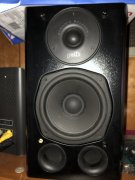J!m
Veteran and General Yakker
My precious monitors, that cost no less than $9 (for the pair) sound fine for the most part. But I noticed recently on some material the left tweeter seems a bit sibilant compared to the other.
Anyone have an idea? I thought perhaps the ferrofluid needs to be replaced perhaps? I’ve never done that before, but that doesn’t usually stop me…
Let’s hear your thoughts.
Anyone have an idea? I thought perhaps the ferrofluid needs to be replaced perhaps? I’ve never done that before, but that doesn’t usually stop me…
Let’s hear your thoughts.

